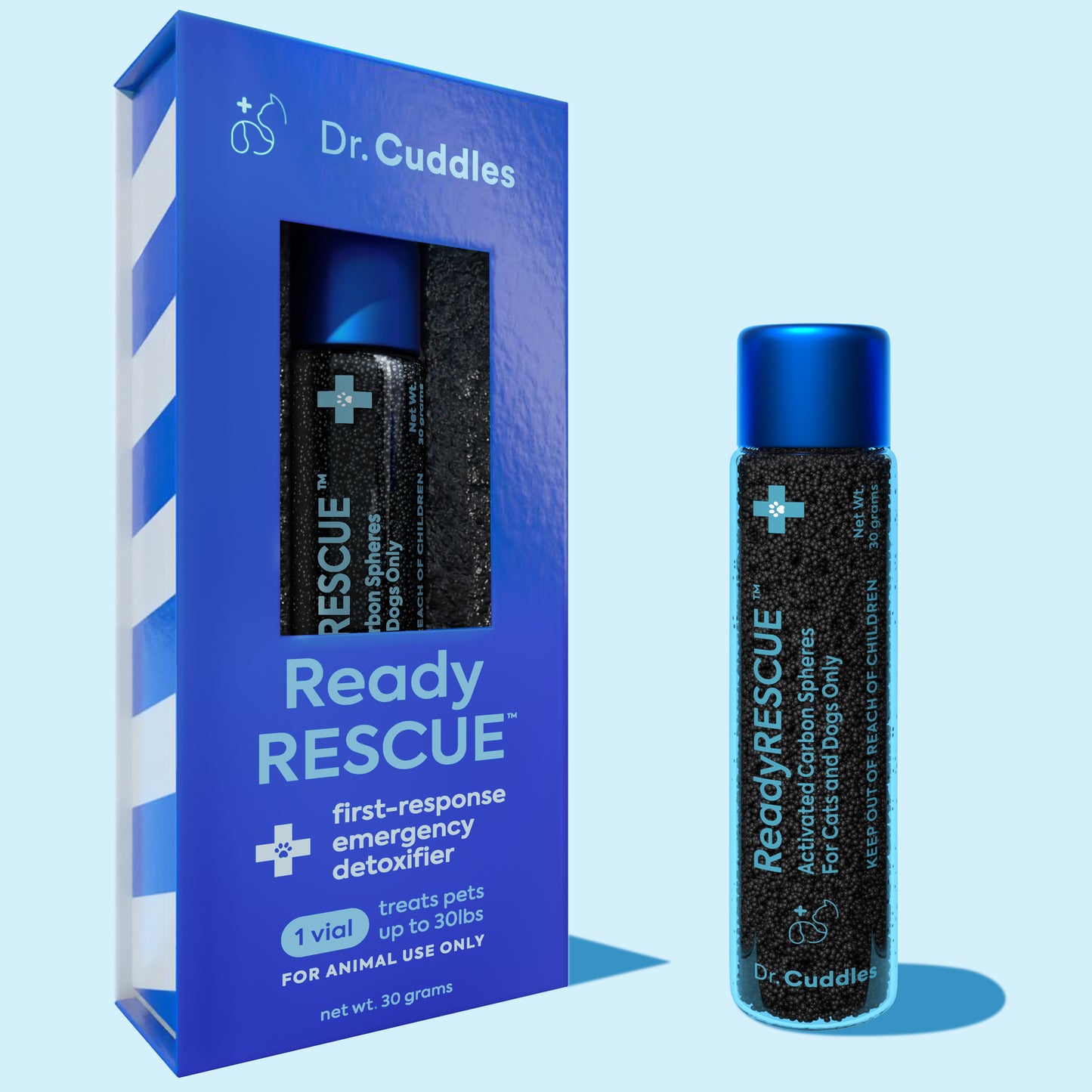

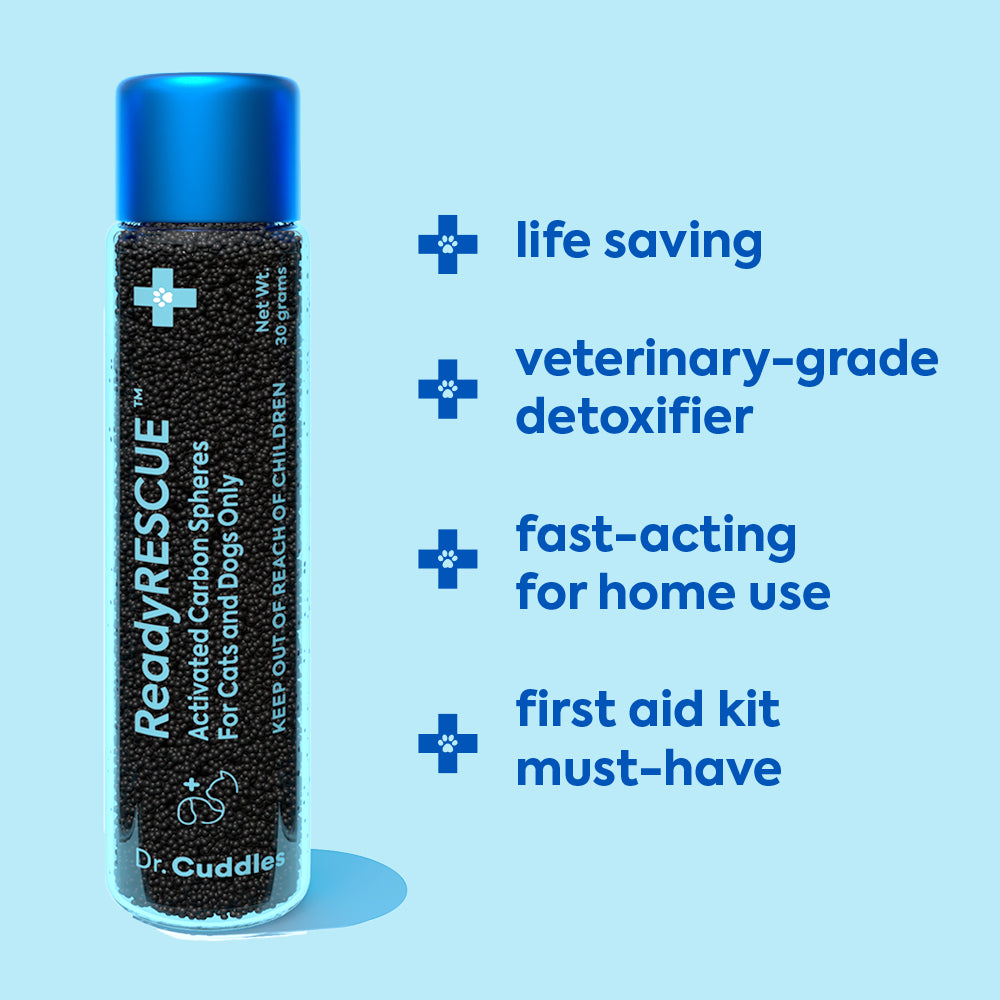
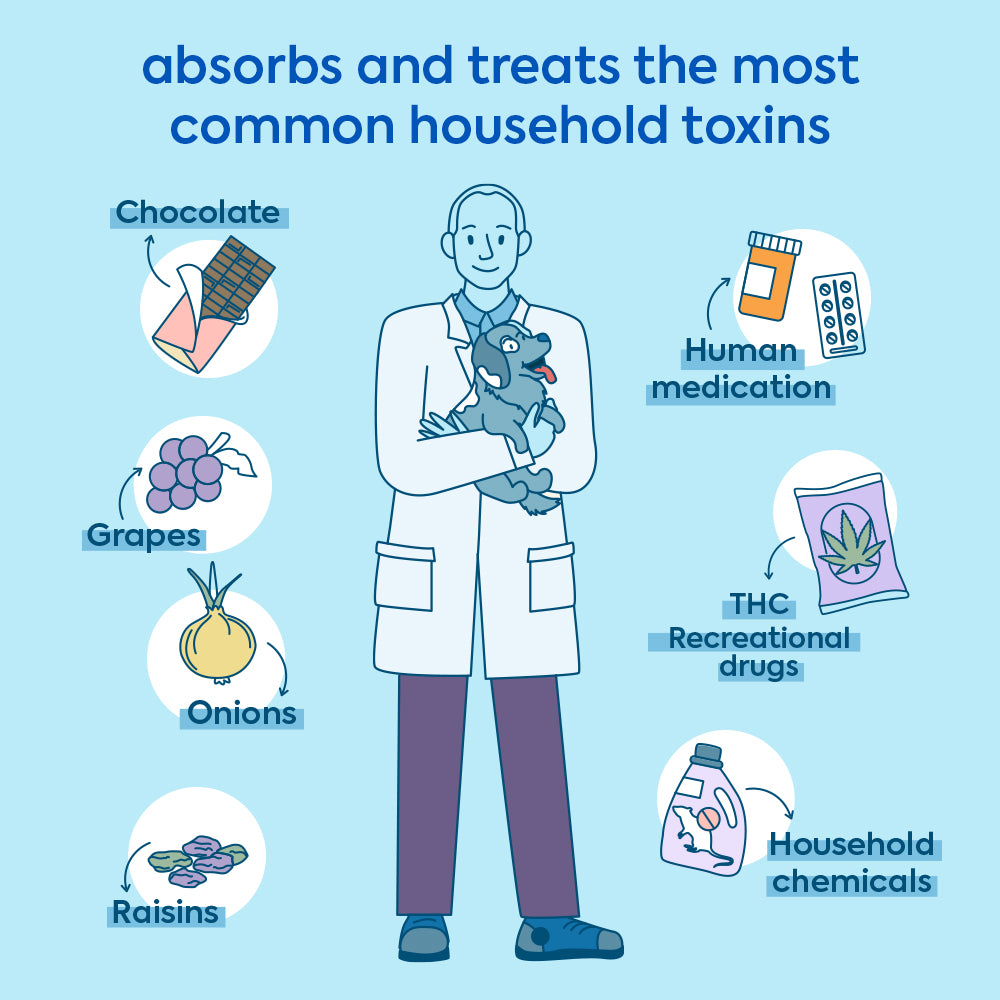
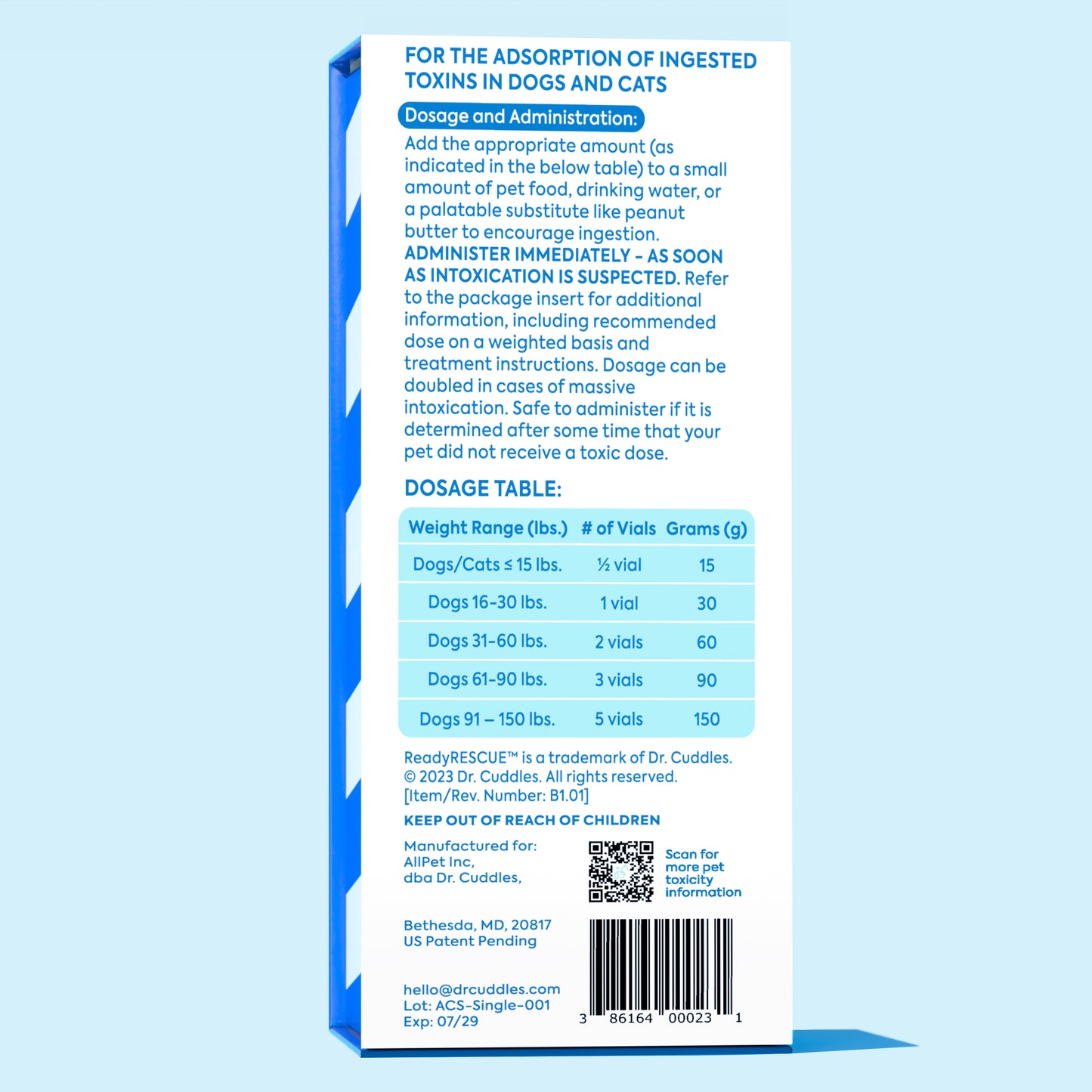
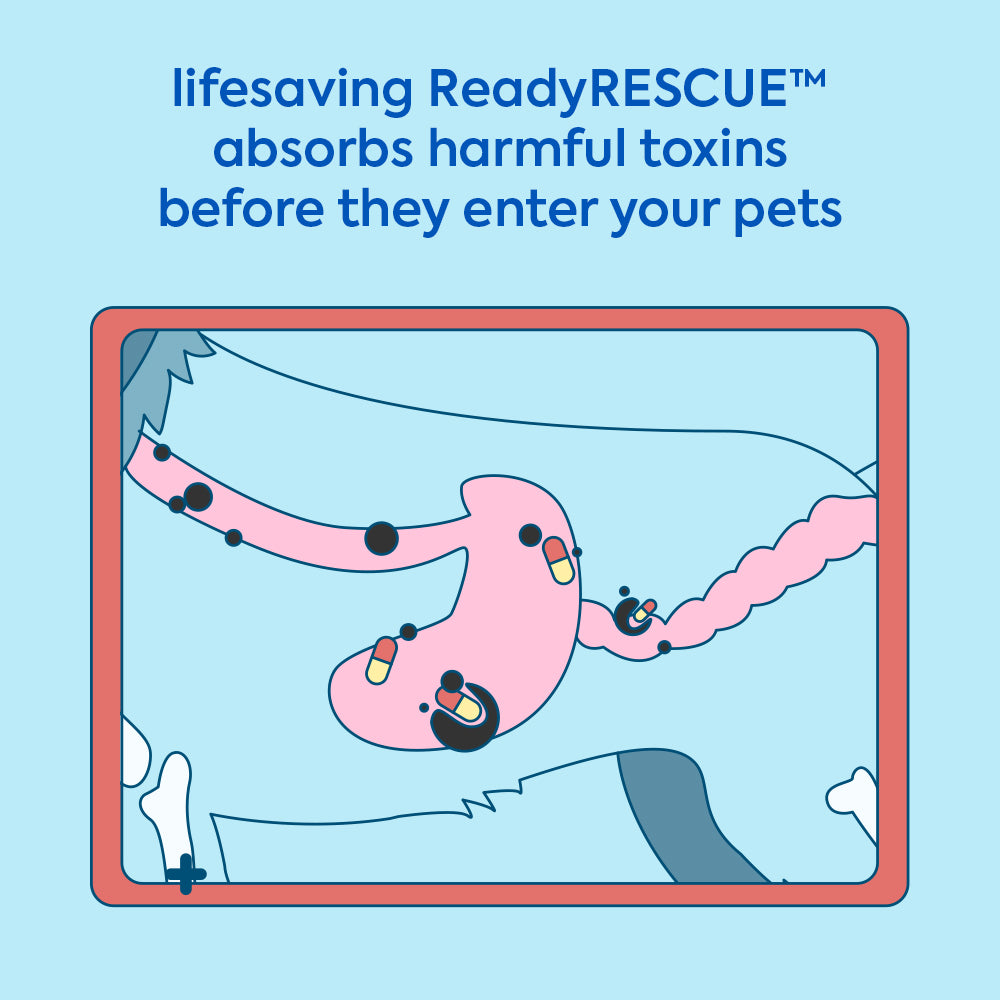
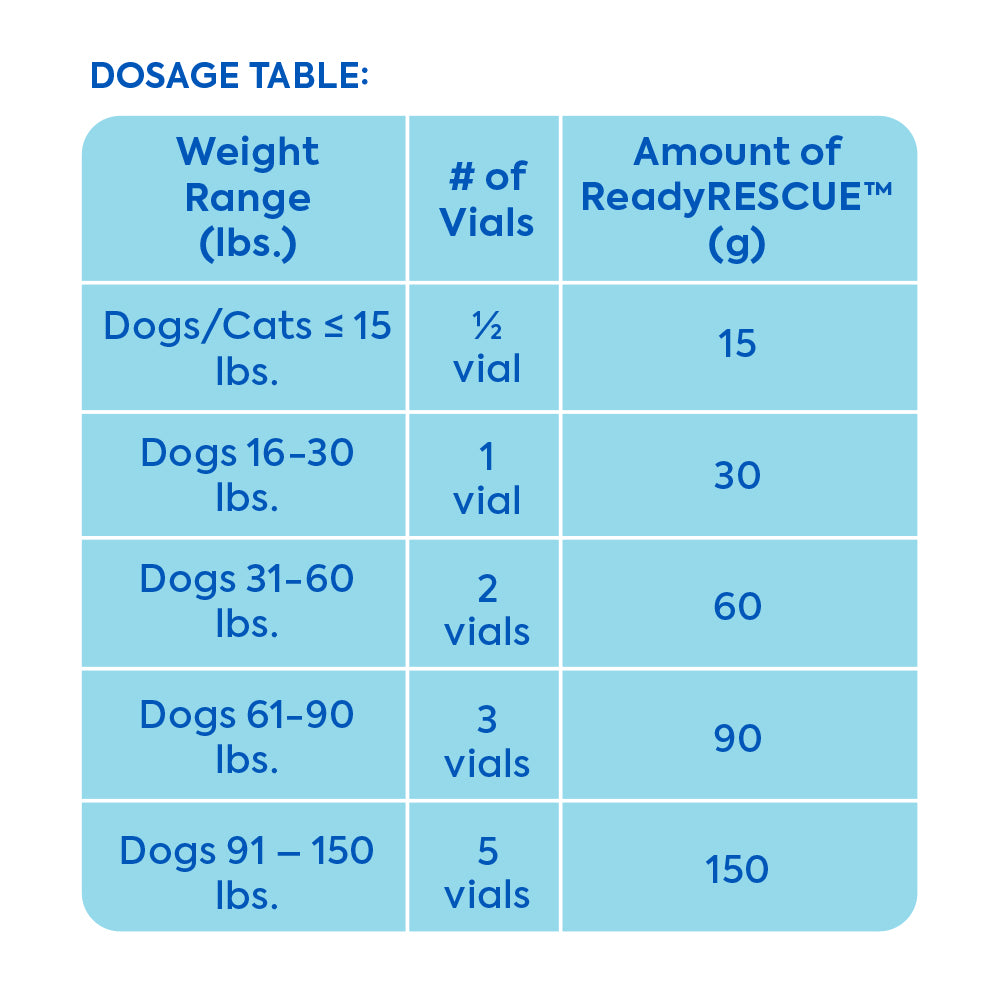
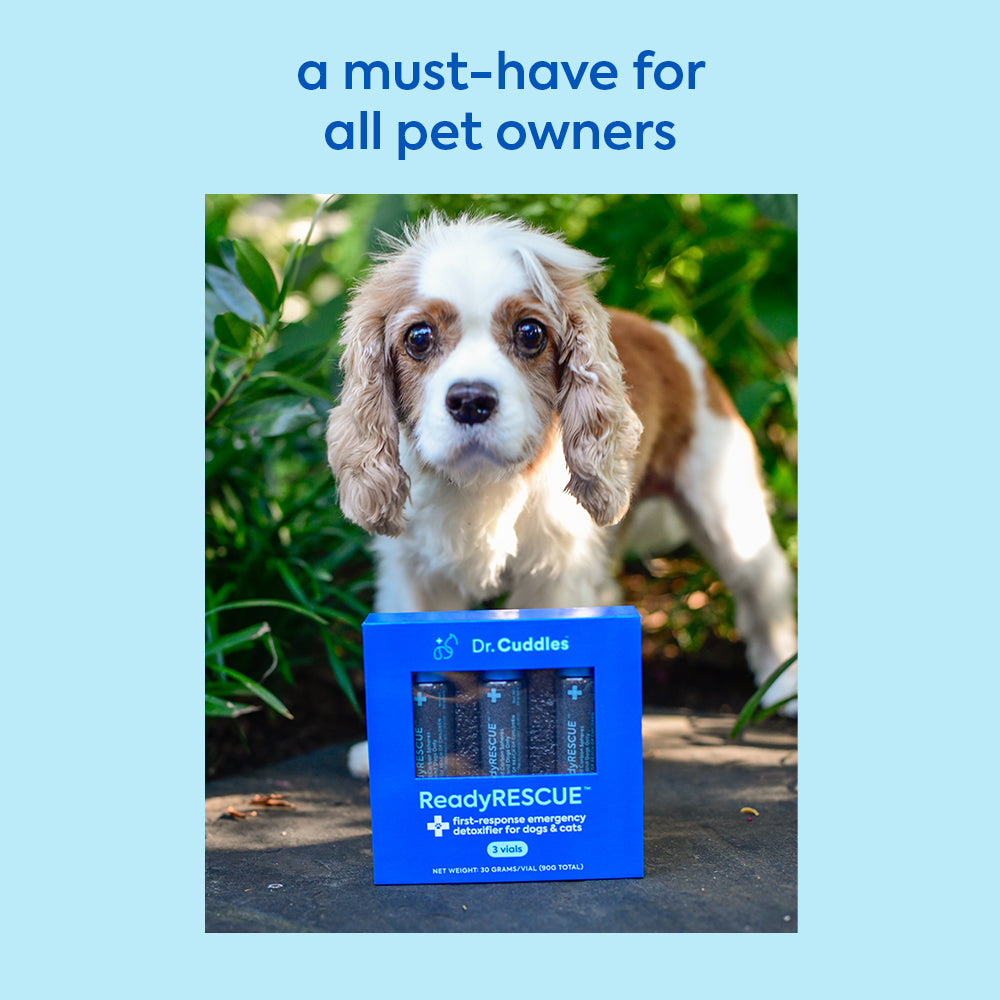

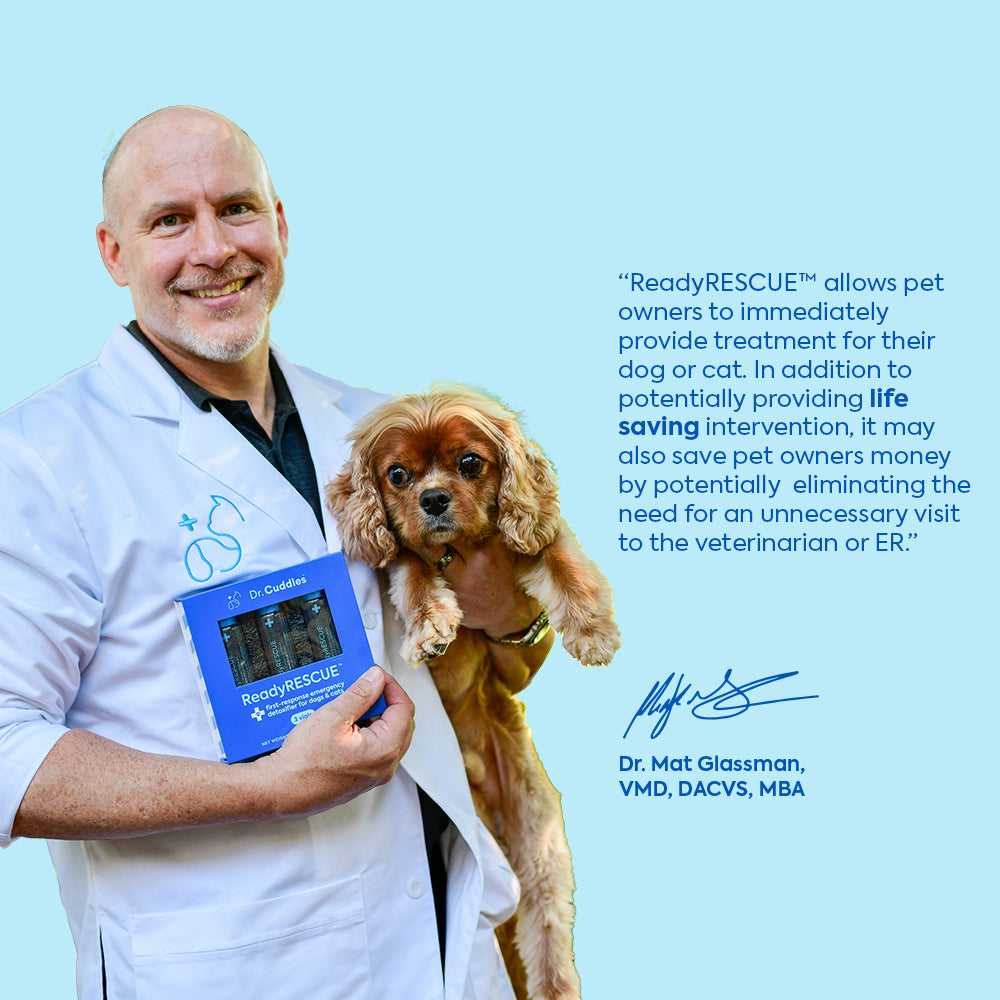
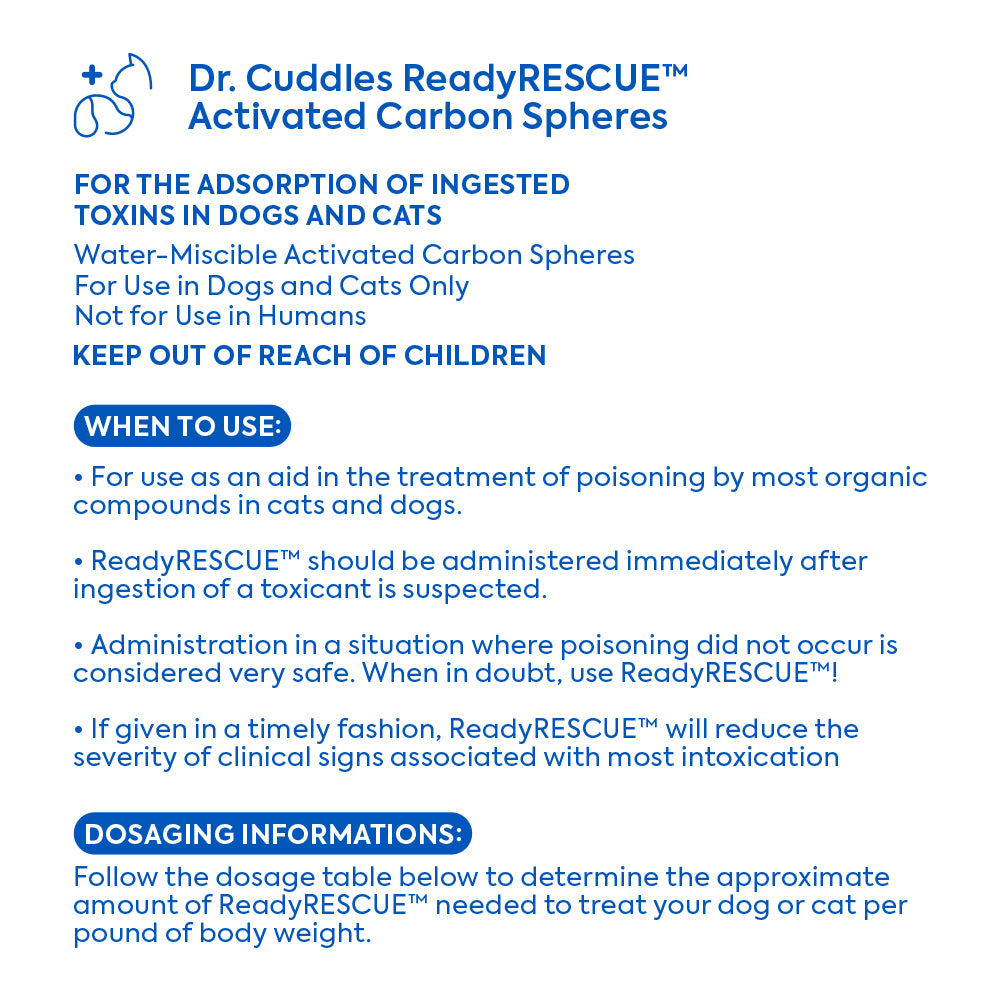
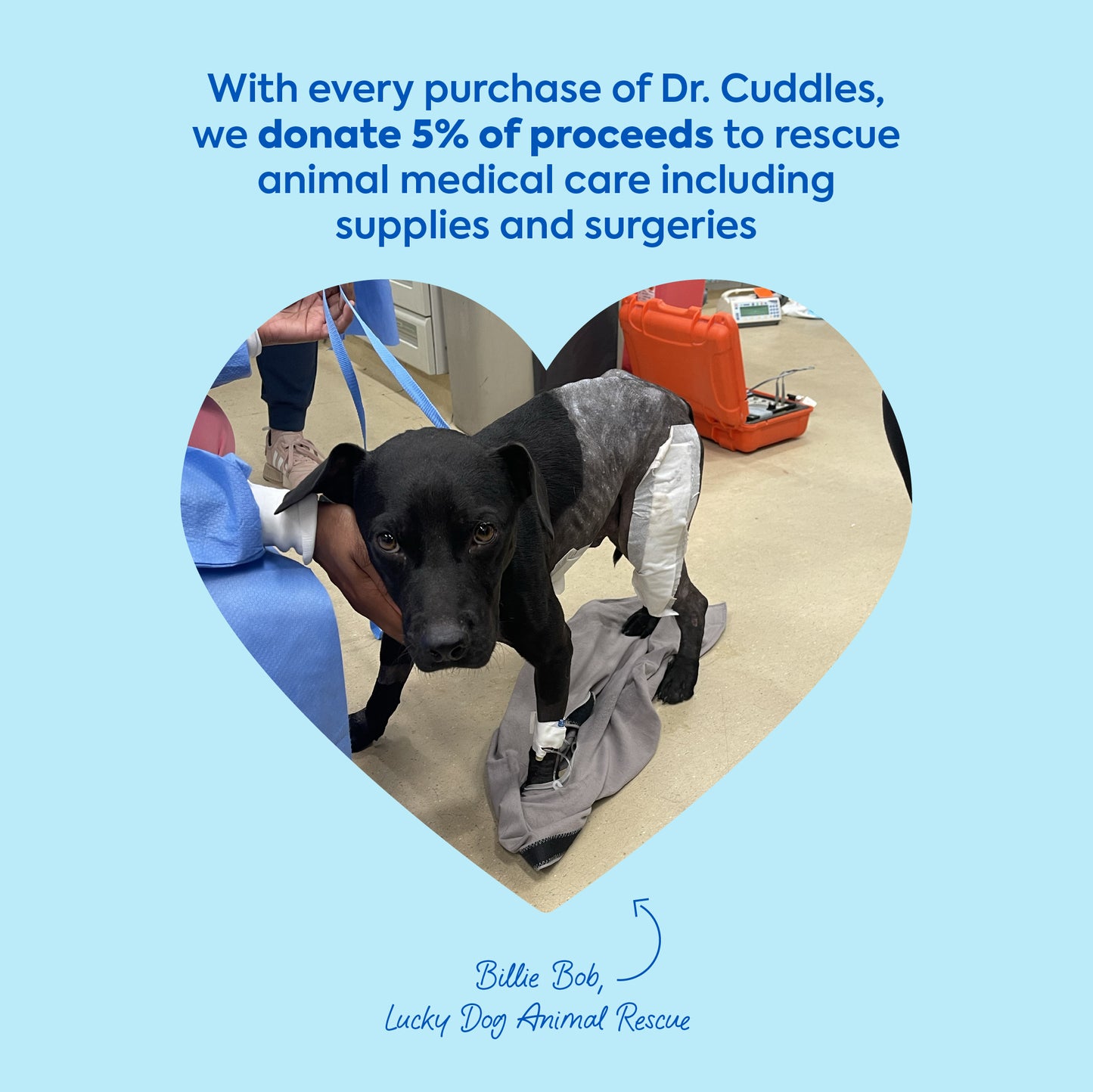
ReadyRESCUE™ explainer
how to administer
ReadyRESCUE™
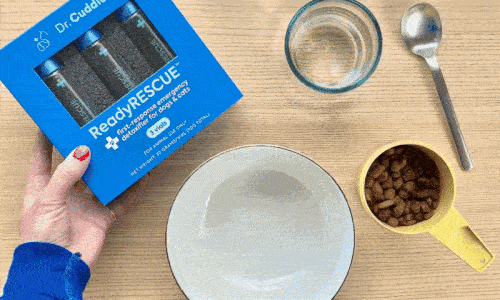
1
act fast
administer as soon as you realize your pet may have eaten something toxic
2
administer
mix the appropriate amount of ReadyRESCUE™ based on your pet’s weight with a liquid treat or food and give to pet
3
follow up
contact pet poison control & your vet to determine if additional care is needed
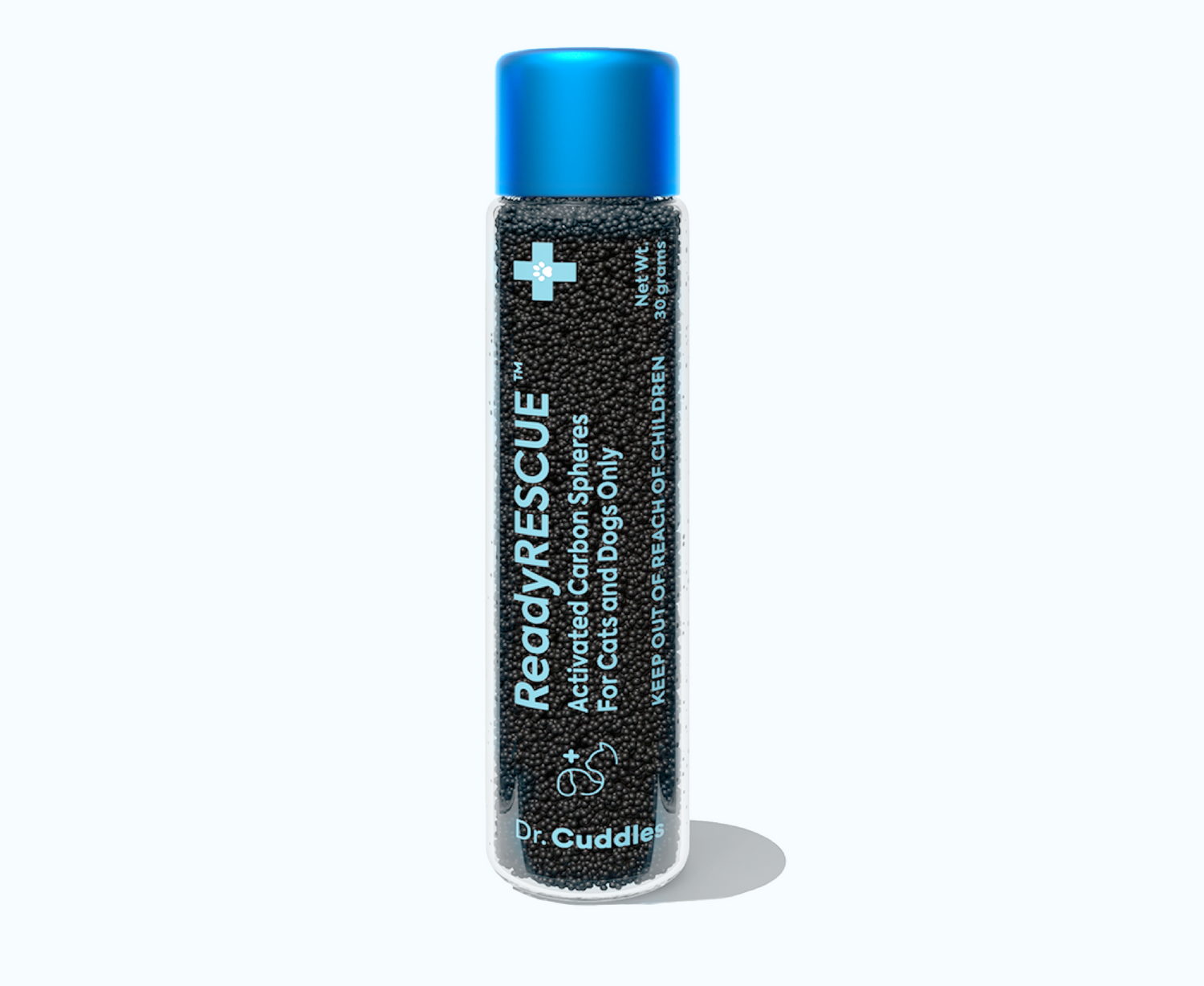
safe, even in cases where no intoxication occurred:
- completely safe for ‘what if’ situations
- 99.9% pure
- made from 95% carbon
- non-toxic
- veterinary crafted
- hospital grade
recommended dosage
based on your pet:
dogs and cats < 15lbs

½ vial
dogs
16 - 30lbs

1 vial
dogs
31 - 60lbs

2 vials
dogs
61 - 90lbs

3 vials
dogs 91 - 150lbs

5 vials
We recommend having a minimum of
2 doses per pet on hand at all times
ReadyRESCUE™ vs. vomiting (hydrogen peroxide)






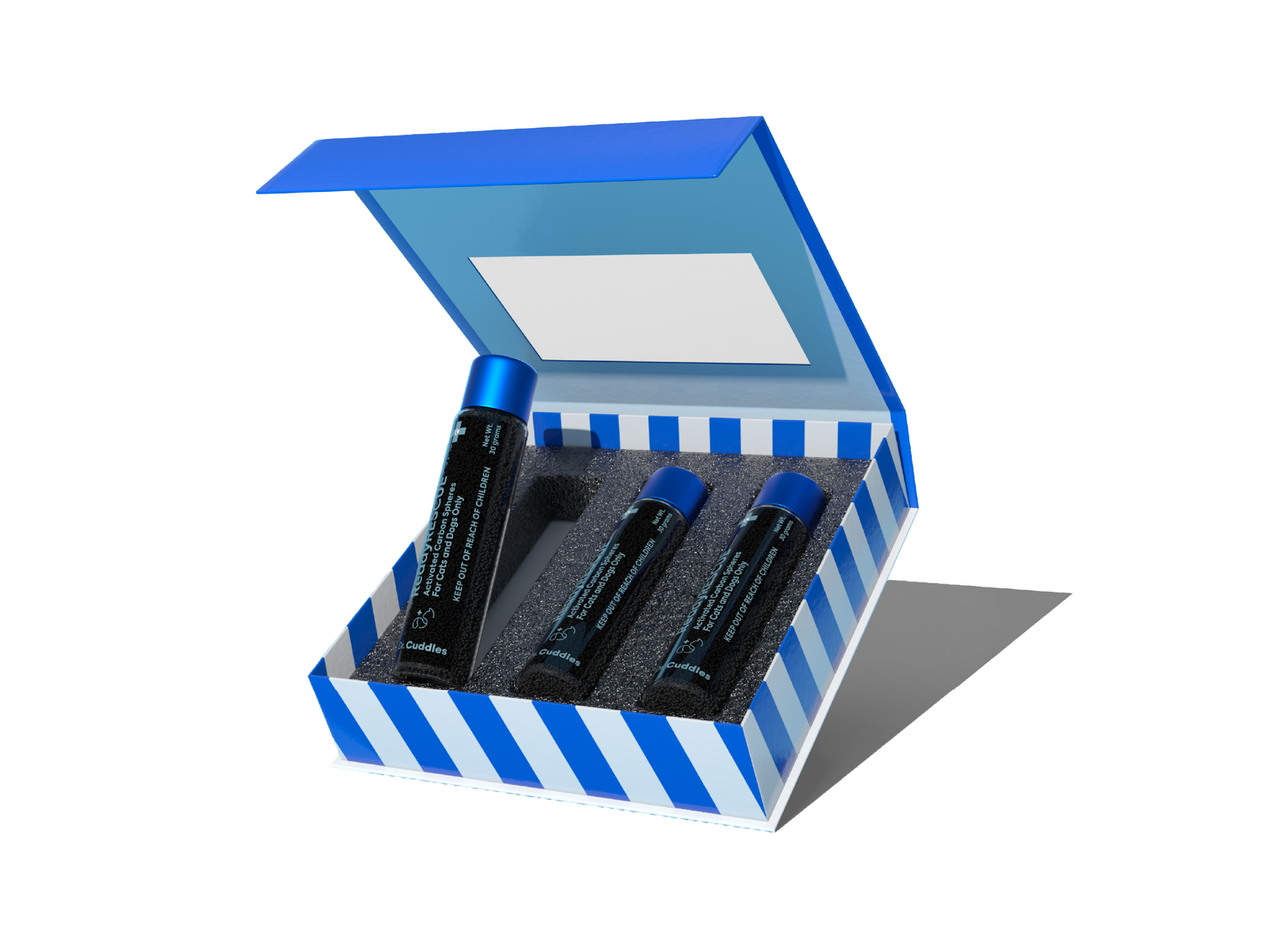
read more about the supporting research behind ReadyRESCUE™
read nowFAQ
historically activated charcoal is created through pyrolysis (setting fire to) organic compounds (like coconut fibers or other organic compounds) creating a carbon rich char (ashes), that are then activated with oxidizing gasses - this creates a mixture of small and large carbon particles that are typically powdered and super messy. our activated carbon is a synthetic activated charcoal that is made to remove the mess from activated charcoal and to improve the uniformity of the molecules. as a result, it is more dense than traditional powdered charcoal, it is clean (because the molecular size is uniform and larger than those that get stuck in irregular surfaces) and it is tasteless. we call our activated carbon/charcoal advanced to differentiate it from the traditional charcoal. because our activated charcoal is clean, dense (6x more dense than the most common charcoal used in hospitals today) and tasteless, it is easy to administer consistently at home (less volume, and no mess). additionally, it has an increased purity and has a shelf life that is 3x many traditional activated charcoals.
the FDA does not officially regulate medical devices, which is ReadyRESCUE™ classification since it does not alter the internal functions of the body, but merely passes through toxins in tow. that being said, ReadyRESCUE™ was crafted following all rules and recommendations of the FDA by our CEO, a board certified veterinary surgeon, and our veterinary advisors, including a board certified anesthesia & critical care veterinary specialist and a board certified internal medicine doctor with a masters in toxicology & pharmacology. rest assured there is ample medical rationale and expertise behind our products that make them safe and effective for your pets.
although hydrogen peroxide is a common method for inducing vomiting when an animal has ingested a toxin, our veterinary specialist advisory panel does not recommend this method over ReadyRESCUE™. immediate activated charcoal administration has been shown to be the most effective remedy for absorbing toxins quickly and safely before other methods advised by your veterinary team or poison hotline.
in addition to putting animals at risk of aspiration pneumonia with vomiting, there is a lot of research that strongly suggests that inducing vomiting does not prevent toxin absorption, because it is inconsistently effective:
- Khan et al (2012) showed that vomiting induced by hydrogen peroxide only produced the toxicant in 60% of cases. and when it did work, it only produced on average 45% of the toxicant, leaving 55% to be absorbed by the body.
- two separate studies performed by Abdallah Tye et al (1967) and Tandberg and Murphy (1989) showed that when apomorphine ( a more effective vomiting agent used in hospitals) was used to make animals vomit, the experimental toxicant (a barium tracer) was only recovered in 54% and 47% of animals.
- the lack of efficacy of vomiting for consistently producing toxin from stomachs was also found in humans where apomorphine and syrup of ipecac only produced toxicants in the vomit of 31 and 28% of children respectively.
when evaluating the literature, inducing vomiting is not as effective as administering activated charcoal at home, prior to seeking veterinary care.
ReadyRESCUE™ 's creation and medical rationale has been overseen by our founder and board certified veterinary surgeon, Dr. Mat Glassman. in addition to his expertise and credentials, the ReadyRESCUE™ product development has been guided by our Dr. Cuddles advisors, Dr. Benjamin Brainard (Veterinary Board Certifications in Anesthesia and Emergency and Critical Care) and Dr. JD Foster (Masters in Pharmacology and Toxicology, and Veterinary Board Certification in Internal Medicine, including Nephrology, Urology and Dialysis). ReadyRESCUE™ has been tested with common intoxicants and found to be equally effective to activated charcoal and Toxiban (the most common in hospital activated charcoal) by weight. ReadyRESCUE™ was also tested in house and by a third party for impurities.
the active ingredient in ReadyRESCUE™ has been used in dialysis tubing to purify blood and remove toxins in patients that have poisons and toxins already absorbed by the body. as a result the level of scrutiny and purity of this product is leaps and bounds above a typical oral activated charcoal.
ReadyRESCUE™ ’s creation and medical rationale has been overseen by our founder and board certified veterinary surgeon, Dr. Mat Glassman. in addition to his expertise and credentials, the ReadyRESCUE™ product development has been guided by our Dr. Cuddles veterinary advisors, Dr. Benjamin Brainard (Veterinary Board Certifications in Anesthesia and Emergency and Critical Care) and Dr. JD Foster (Masters in Pharmacology and Toxicology, and Veterinary Board Certification in Internal Medicine, including Nephrology, Urology and Dialysis).
ReadyRESCUE™ is supported by 50+ years of activated charcoal research in both human and animal medicine. there is so much research that there are multiple text books written about activated charcoal for medicinal purposes. ReadyRESCUE™ is a synthetic and more advanced form of activated charcoal, that is cleaner, more dense, and without additional ingredients which make it easy to administer, and incredibly safe to use.
we do not recommend making you pet vomit prior to ReadyRESCUE™ administration for several reasons:
- first, ReadyRESCUE™ needs to be in your pets stomach ASAP to bind the toxin and prevent adsorption. vomiting takes 5-15 minutes to initiate and lasts for 45 minutes. if you were to delay ReadyRESCUE™ administration by 1 hour there could be a fair amount of toxin absorption by the body during that time.
- second, vomiting is an inconsistent mode of stomach decontamination- it only works 60% of the time (to remove any toxin) and when it does work, it only removes on average 45% of the toxin. that means that 40% of the time, it does not work at all, and 60% of the time, it leaves 55% of the toxin in the body to be absorbed. ReadyRESCUE™, on the other hand, takes 2-5 minutes for a pet to eat, begins working immediately, and works in the stomach and the intestines.
- third, there are many side effects of making an animal vomit, including pneumonia, esophageal burns and generally making them feel like they have food poisoning for as much as an hour. ReadyRESCUE™ does not have any of these negative side effects.
unlike other traditional activated charcoals, ReadyRESCUE is incredibly clean and made from pure carbon, excluding the primary ingredient (sorbitol) that can cause imbalanced sodium levels.
activated charcoal products containing sorbitol should be used under the direction of a veterinarian due to the cathartic activity that can result in dehydration and hypernatremia. luckily, since ReadyRESCUE™ excludes sorbitol and other additives, at-home administration is safe & easy. head to our blog to learn more about what sets ReadyRESCUE™ apart from traditional activated charcoals.
the effectiveness of ReadyRESCUE™ for animals in cases of xylitol ingestion is complex. generally, xylitol is absorbed very quickly by the body, and substances like ReadyRESCUE™ might not be able to prevent this absorption effectively. When xylitol is ingested as part of a gummy substance, the xylitol leaches out more slowly, giving ReadyRESCUE™ a chance to reduce its absorption into the body. although the rapid absorption of xylitol will generally make ReadyRESCUE™ a less effective intervention tool, using it immediately after ingestion could still potentially offer some benefit without causing harm.
pets drinking salt water can be very dangerous and can lead to severe hypernatremia (high sodium in the blood), resulting in seizures. ReadyRESCUE™ would not be ideal for salt intoxication because the salt ions are too small for the carbon to bind.
the best thing to do is to prevent your pet from drinking salt water, but in case they sneak in a few licks, it’s helpful to know how much saltwater is harmful for your pet. buckle up for a bit of math!
for a 40lb dog, clinical signs of salt intoxication are seen with 2 pints of salt water ingestion (0.25 gallons). 4 pints for the same dog (half a gallon) can be fatal. dogs drink roughly 300ml a minute, so after about 3.3 minutes of drinking salt water a 40lb dog would drink enough water to experience toxicity- 6.6 minutes of drinking would be fatal. with a bit of research, you can decipher what amount is harmful for your pet- a prepared pet parent = a happy and healthy pet!

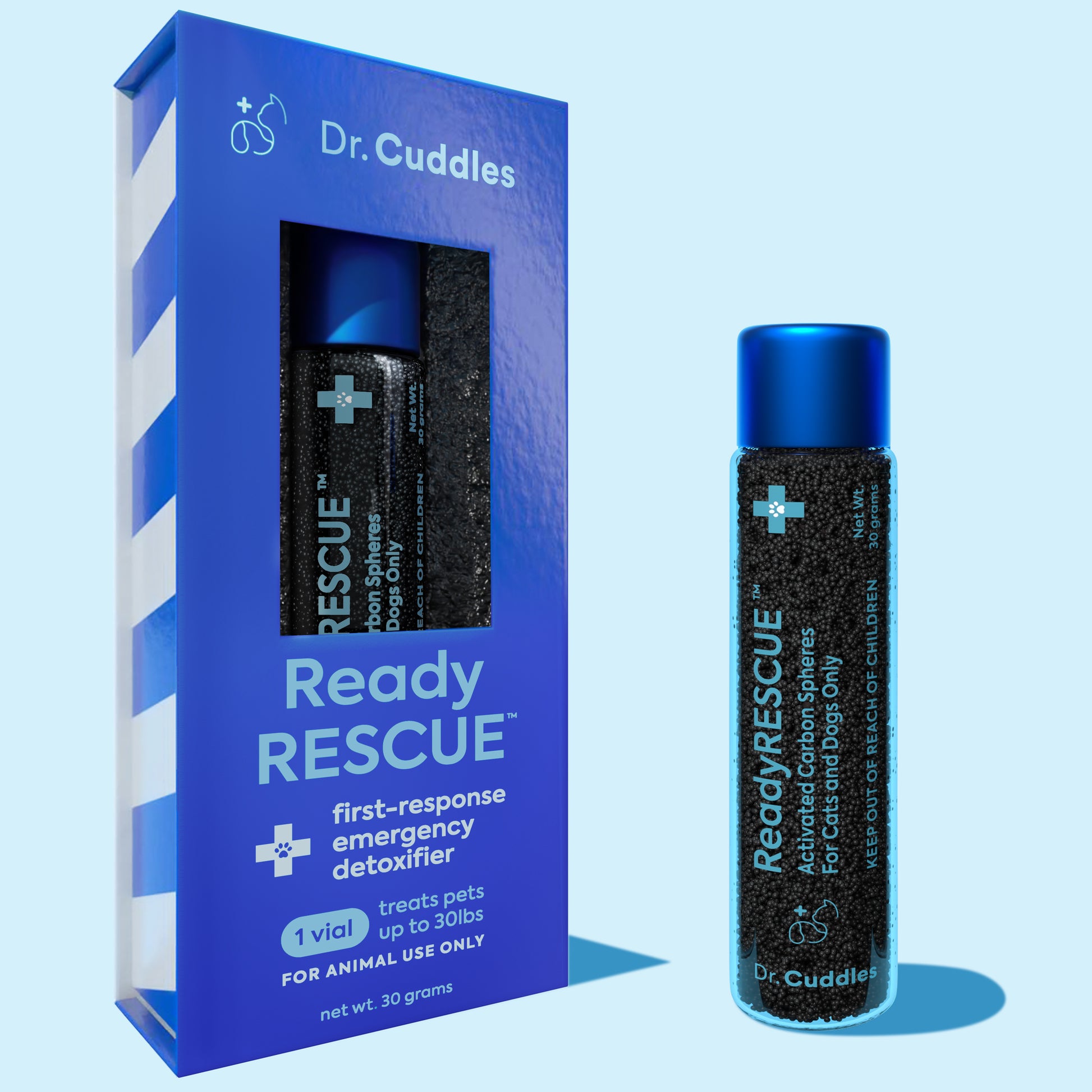
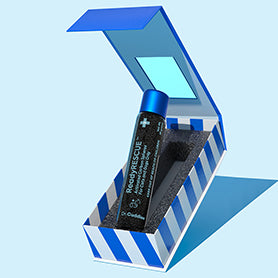
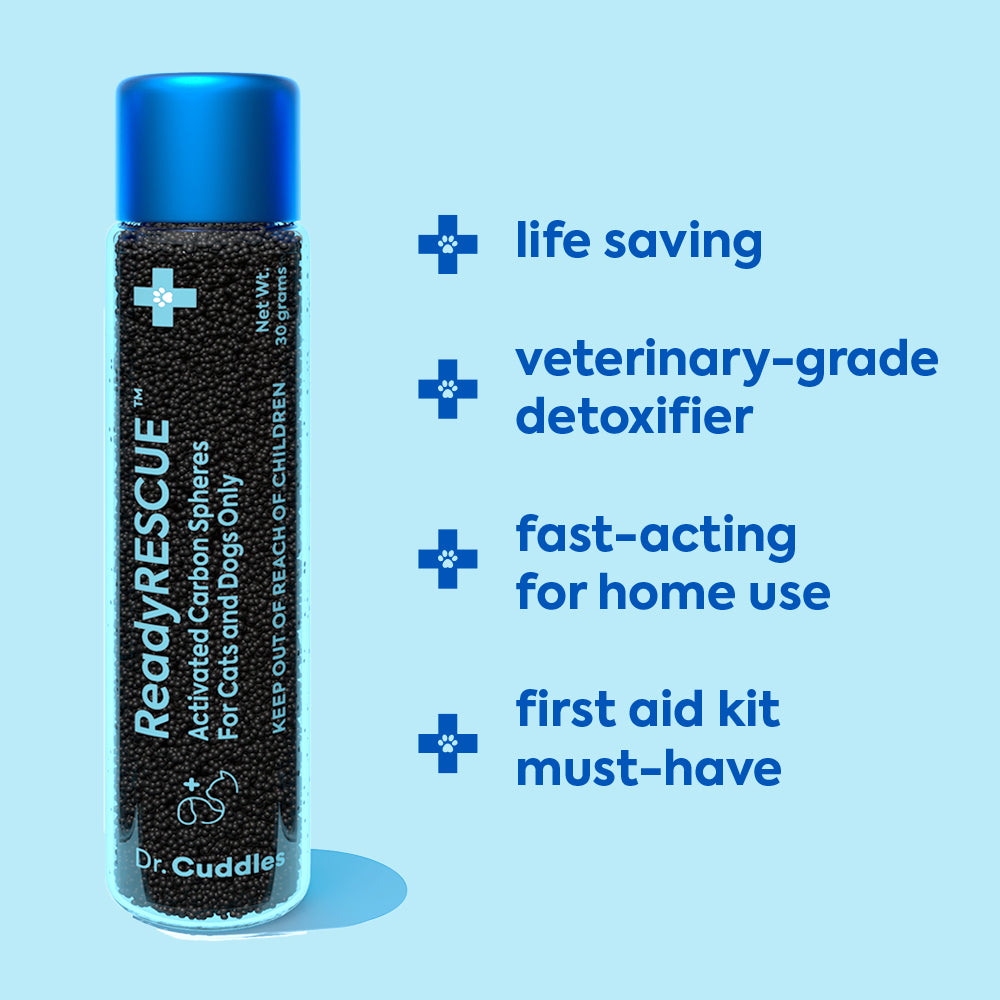
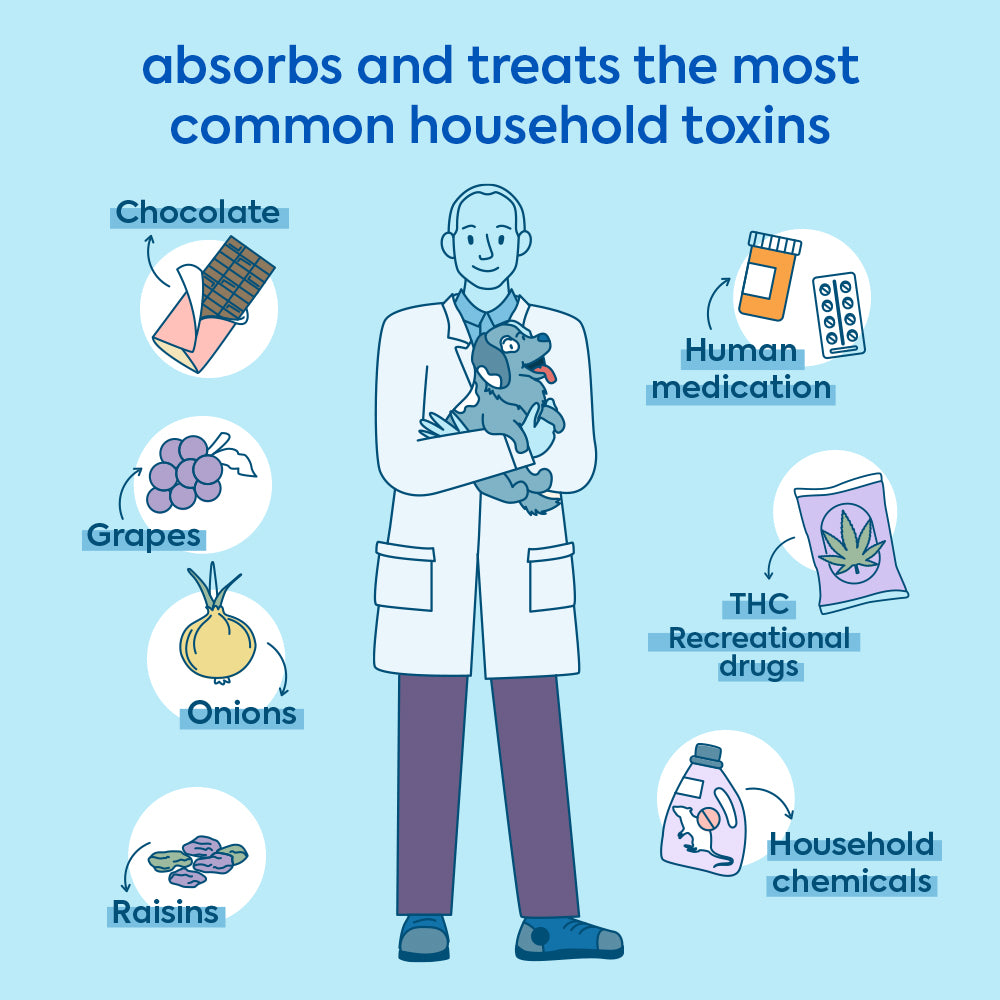
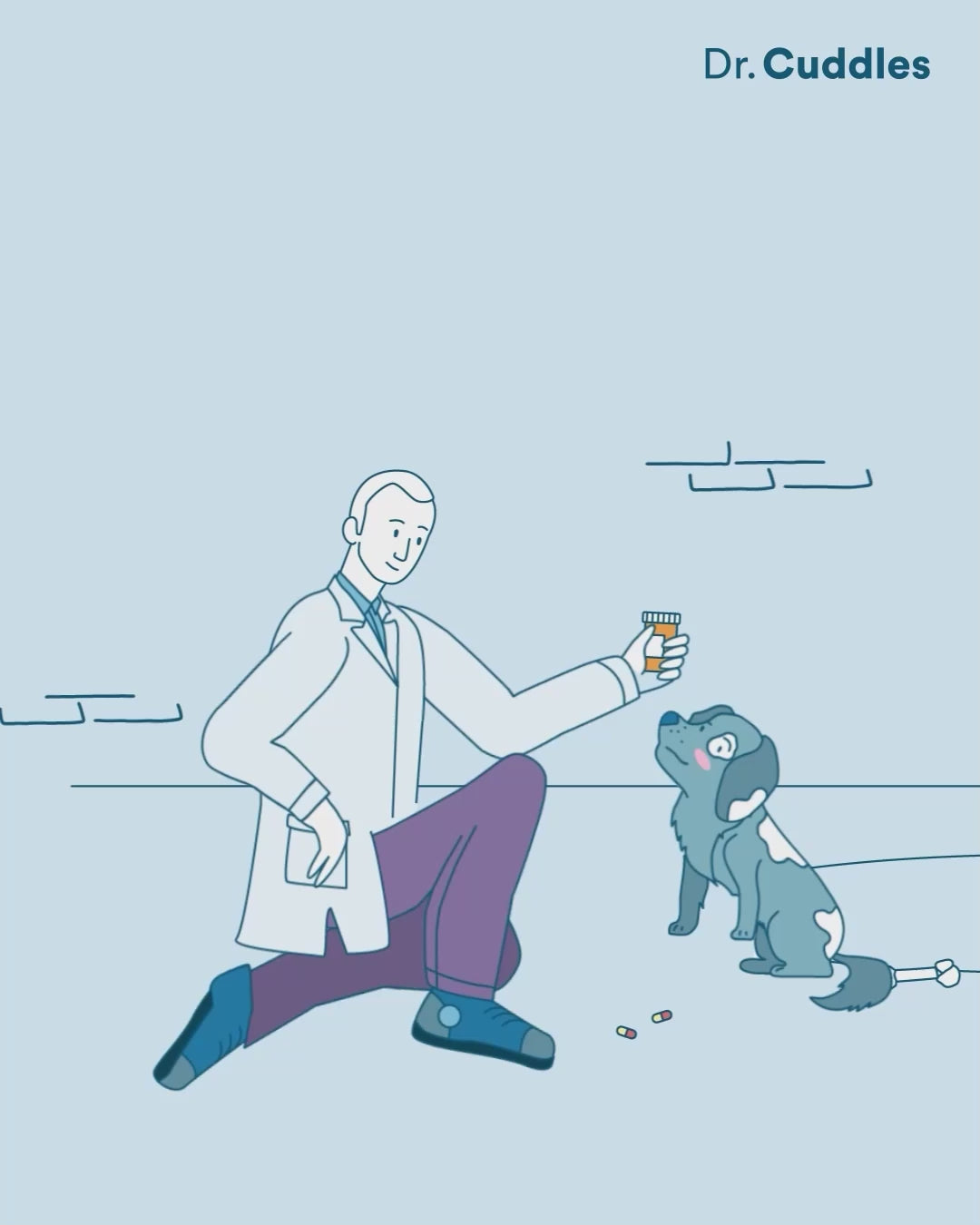
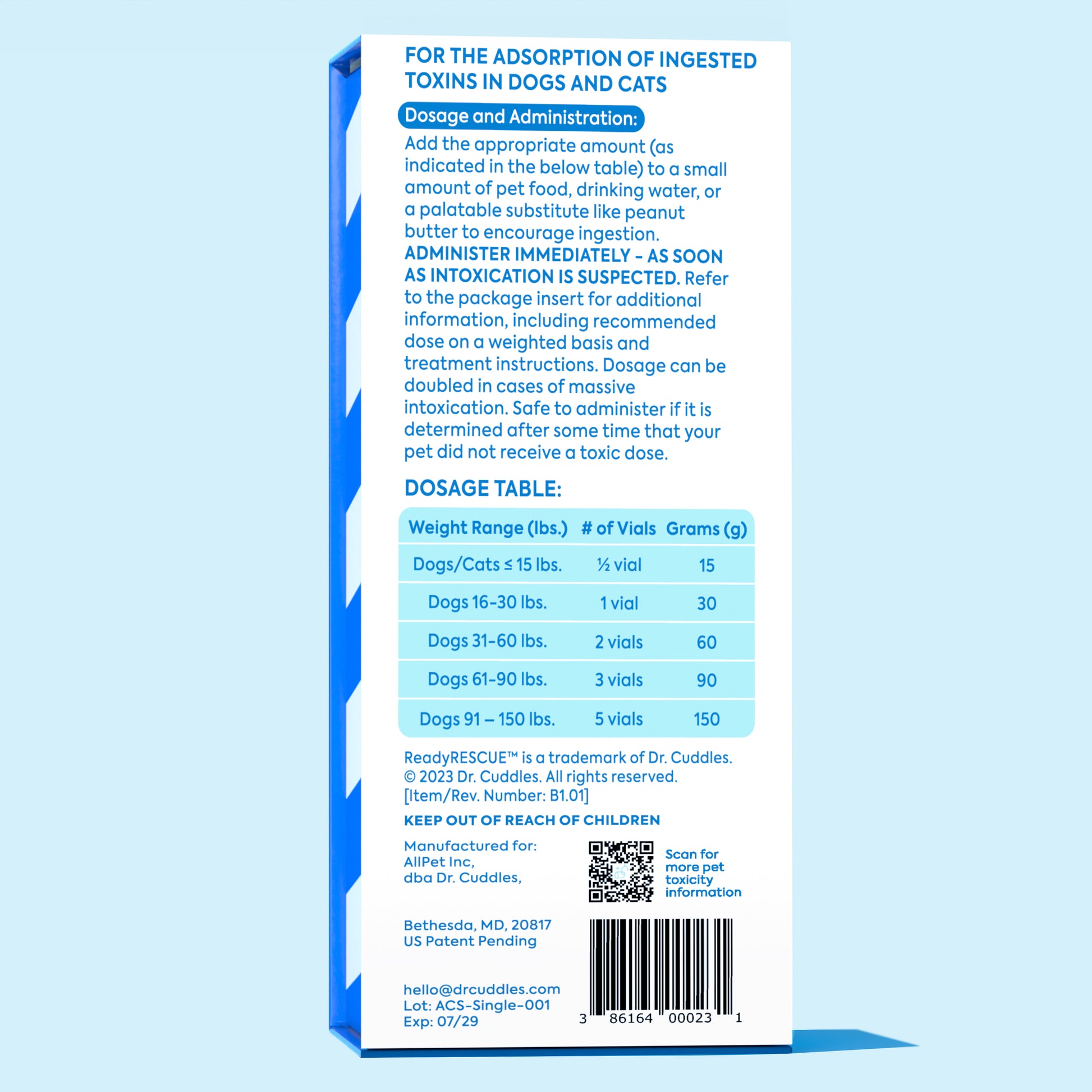
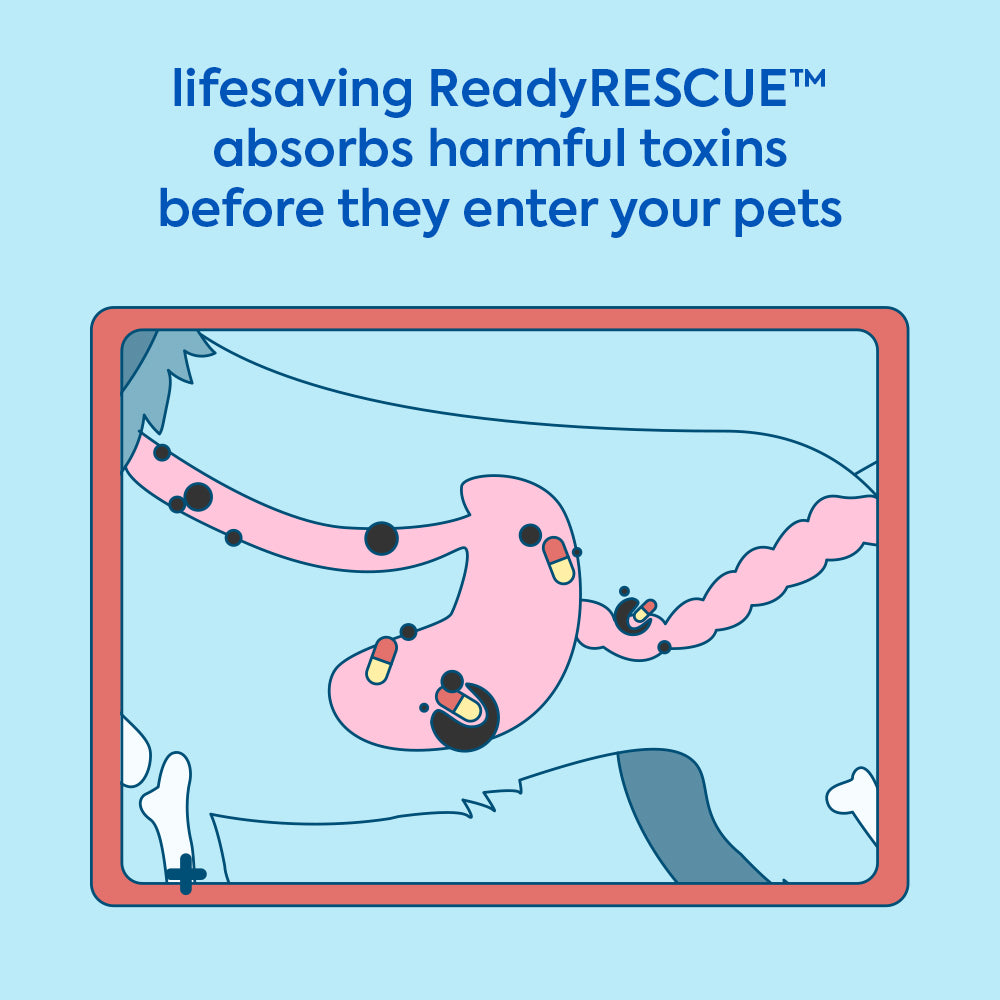
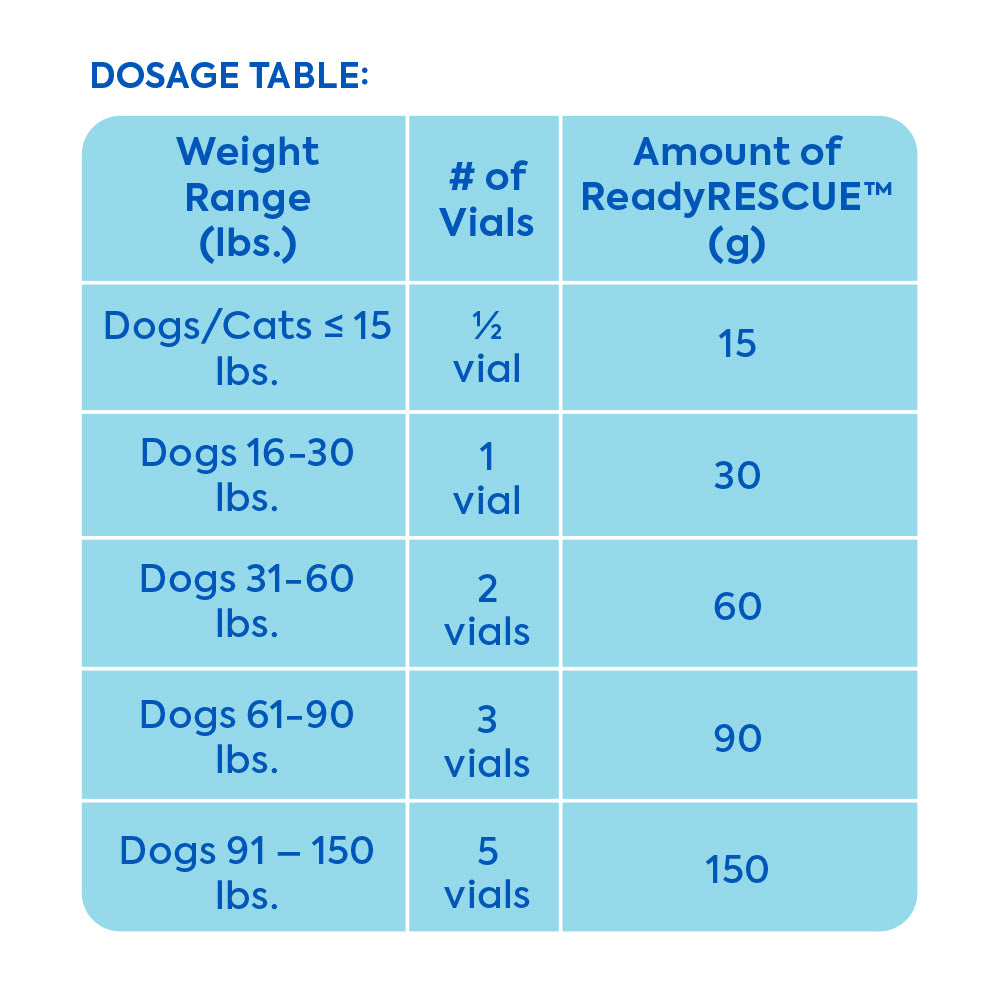
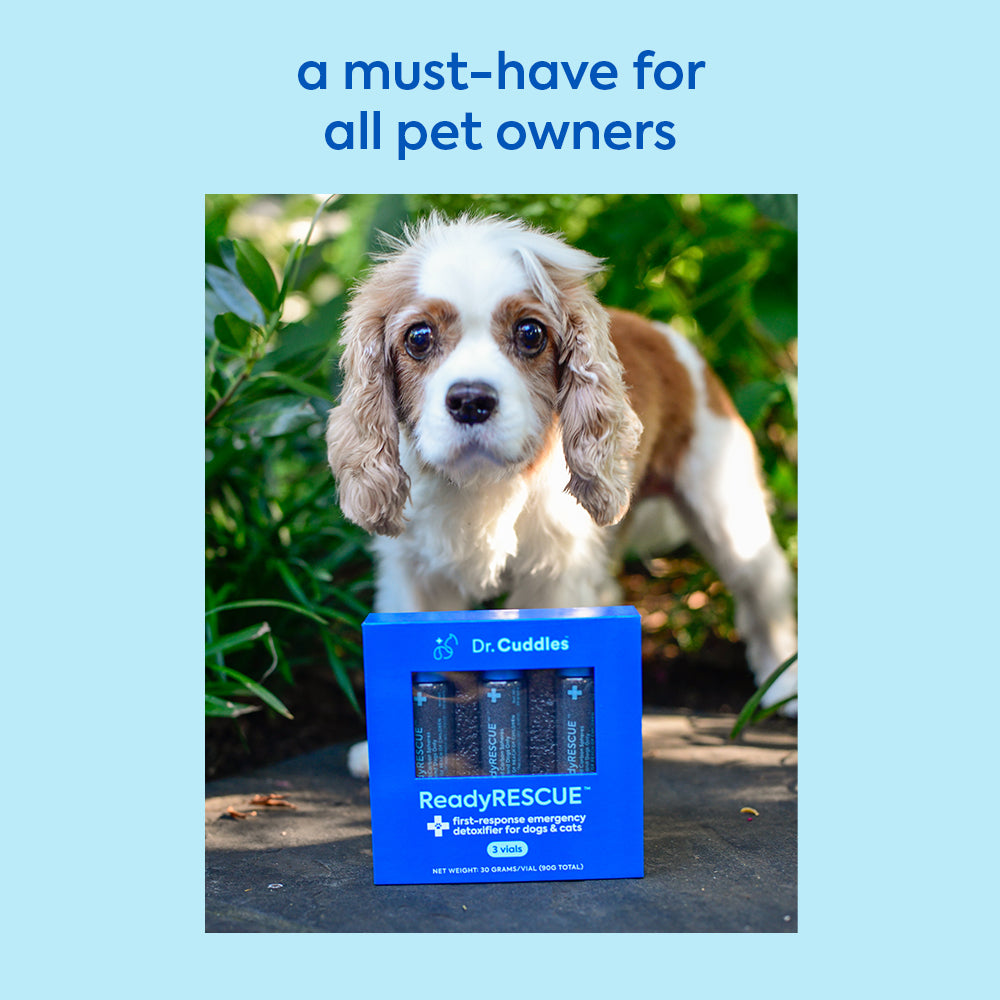

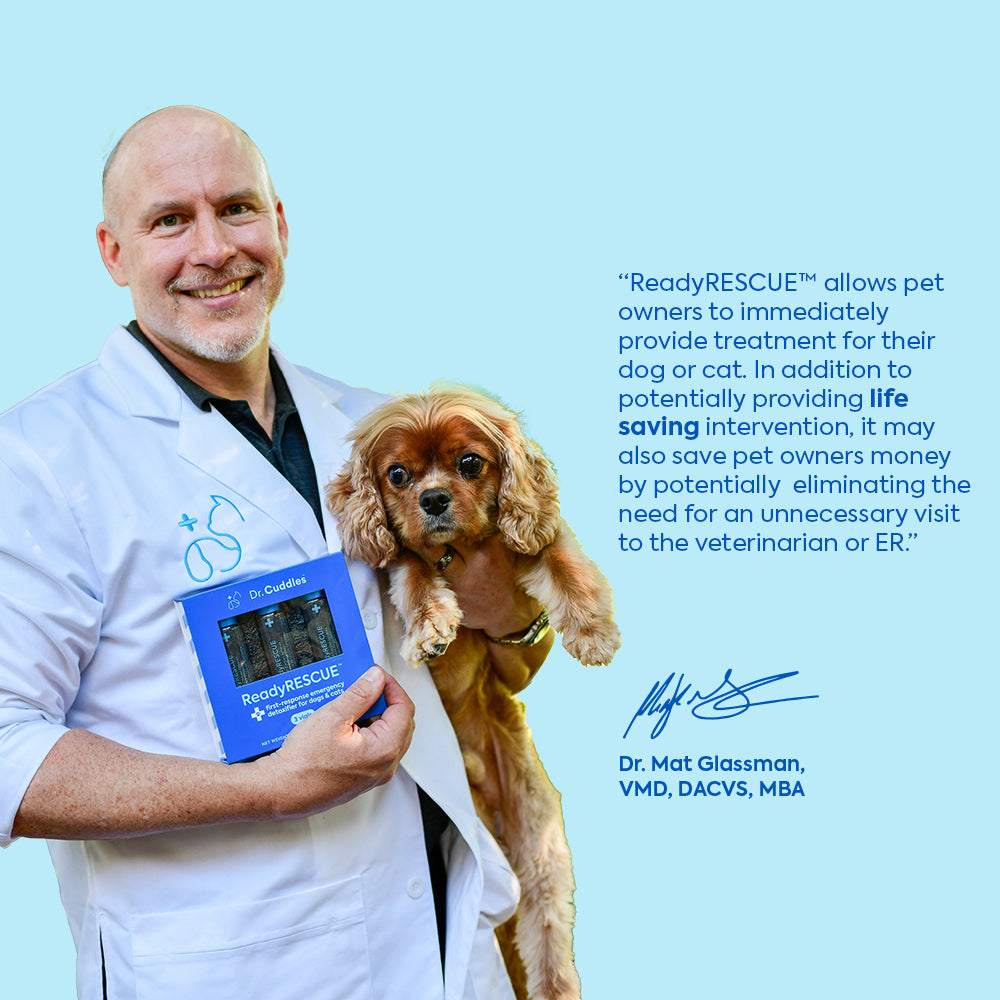
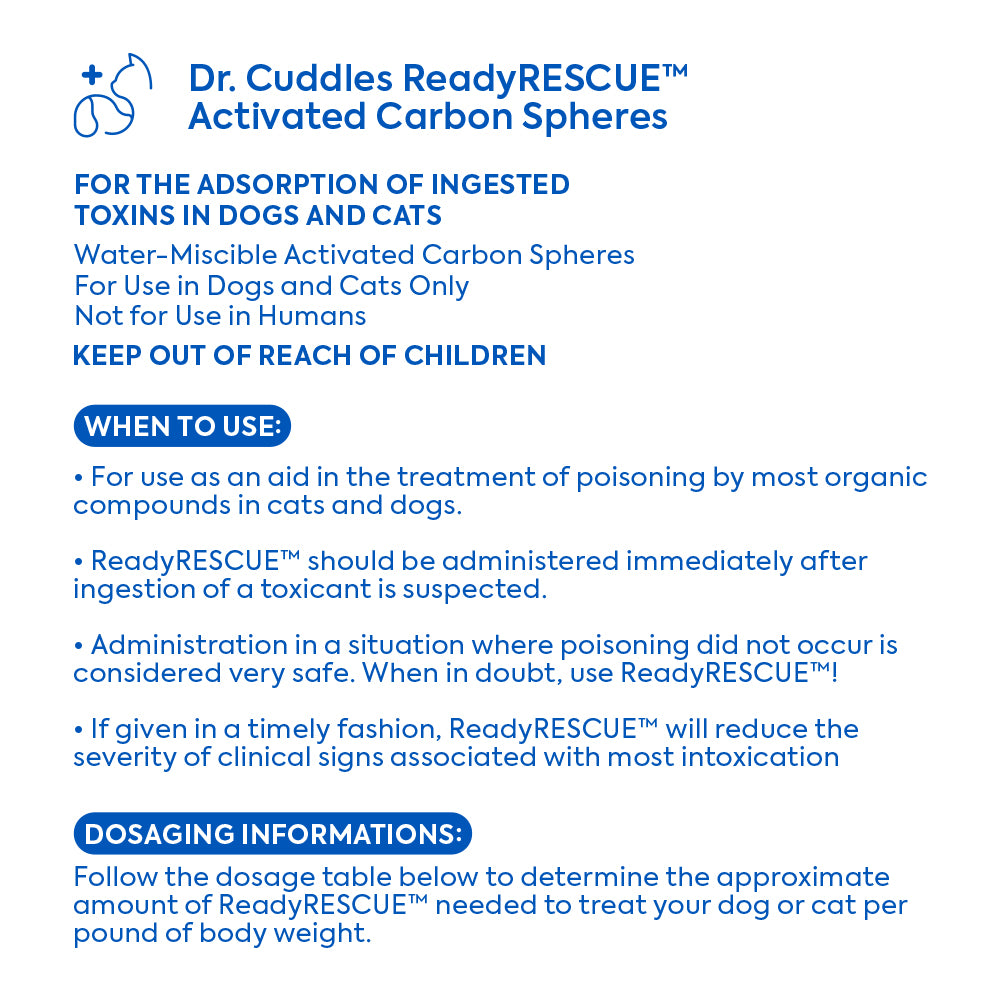
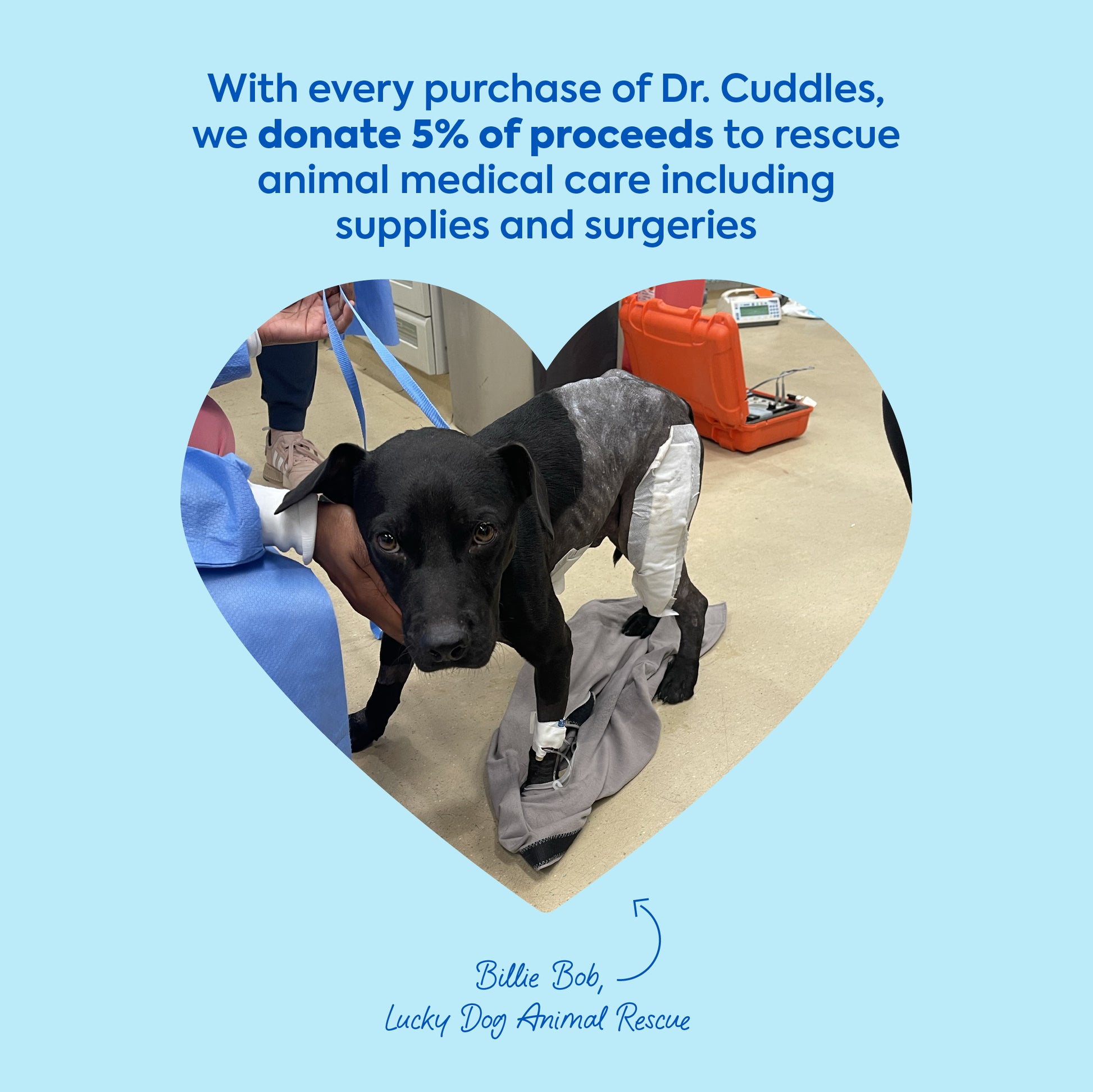
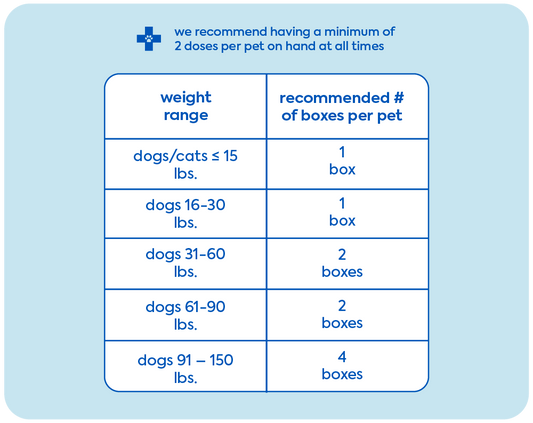





ReadyRESCUE™ in action:
I have two Yorkies - one full sized (named Monster) and the other a teacup (named Bunny). Bunny is about ⅓ the size of her brother.
On Sunday night, I was giving Monster his prescription medication for a yeast issue. Monster was prescribed a pretty potent oral antifungal medication.
As always, I administered his prescribed medication inside of a tasty treat which he ate far too quickly. So quickly, that he vomited it back up. Nearly instantaneously, his tiny sister swooped in to eat up the treat and medication. Because of her size, I started to panic about stomach or intestinal issues from the drug.
Luckily, I remembered I now had ReadyRESCUE on hand! I administered 1/2 of the tube in her canned food and she ate all of it very enthusiastically.
I was happy to think that the carbon spheres would prevent any of the medication from being absorbed and that it would prevent her from getting sick from being such a little pig!
- Dr. Mike Dugan, DVM